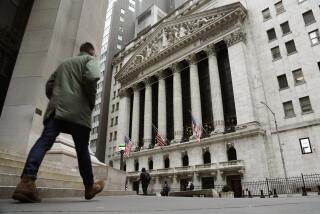Stocks Tumble in Anticipation of Major Boost in Interest Rates
- Share via
NEW YORK — Stocks plunged Friday after a government report of surging fourth-quarter economic growth with unexpectedly high inflation raised fears that the Federal Reserve will raise interest rates sharply at next week’s meeting.
The Dow Jones industrial average sank 289.15 points, or 2.6%, to 10,738.87, its lowest since Nov. 11. The Standard & Poor’s 500 index dropped 38.40 points, or 2.8%, to 1,360.16.
The Nasdaq composite plummeted 152.49 points, or 3.8%, to 3,887.07, its lowest level since Jan. 12. It was the second-worst point drop ever for Nasdaq, after a 229-point tumble on Jan. 4, but not close to a one-day percentage record.
Losers swamped winners on the New York Stock Exchange and Nasdaq, although volume was surprisingly subdued.
The Dow fell below its 200-day moving average--a potential trouble sign to some technical analysts, who follow charts rather than fundamentals. Year-to-date, the Dow is down 6.6%.
Nasdaq is off 4.5% in 2000, though it is 8.2% below its Jan. 21 record close.
The Russell 2,000 small-stock index, which has been performing relatively well so far this year, dropped 2.4% Friday, leaving it all but unchanged for the year.
In the bond market long-term yields tumbled, which some traders said suggests investors believe the Fed will be aggressive in raising the short-term interest rates it controls, leading to an economic slowdown sooner rather than later.
Some Fed watchers who had expected an increase of only a quarter of a percentage point--to 5.75% from 5.5%--in the target “fed funds” rate for overnight loans are now looking for a half-point hike or even more in the Fed meetings next week and in March.
Others, however, warned that long-term bonds may be rallying more for technical reasons. In any case, the 30-year T-bond yield fell to 6.45% from 6.52% on Thursday and is the lowest since Dec. 30.
An unusual “inversion curve” now has maturities such as the two-year notes yielding more than the 30-year T-bond. Traditionally, such an inversion is a predictor of an economic slowdown, even a potential recession, which could forestall further rate increases in the spring.
Stock investors are left to wonder: Are interest rates close to peaking--or is there much worse ahead? And either way, are stocks finally in a significant pullback?
Meanwhile, the dollar surged to a record against the euro at 97.8 cents, and a 3 1/2-month high against the yen, on the economic data and interest-rate expectations.
The Commerce Department report showed that the U.S. economy expanded at a blistering annual rate of 5.8% in the fourth quarter.
“This hit the markets full bore,” said Peter Coolidge, director of equity trading at Brean Murray & Co. “It might tip the scales toward a half-point [Fed] hike.”
In theory, there are two ways that the current environment ought to cool off the stock market. First, because bonds compete with stocks for the investment dollar, rising yields make them more attractive. Second, if the Fed succeeds in slowing the economy, there is a danger that corporate profits also will falter.
“People are beginning to complete the loop,” said Hilton Jervey, chief investment officer at Summit Bank in Princeton, N.J. “If the Fed’s really serious about slowing the economy, it’s not a very good picture for profit margins.”
Stocks with the steepest price-to-earnings ratios could be the most vulnerable in such a scenario. Nasdaq’s recent troubles--not just this week but also the composite’s nearly 10% pullback in the first week of the year--have convinced some analysts that the day of reckoning has arrived.
“Given how robust growth was at the end of ’99 and the fact that inflationary pressures are more pronounced, the assumption that we could have a nice smooth landing in 2000 has really been called into question,” said Douglas R. Cliggott, chief equity strategist at J.P. Morgan Securities.
Several Wall Street strategists are calling for pullbacks of 10% to 20% over the next few months.
About the only sector that escaped Friday’s carnage was pharmaceuticals, which rallied, traders said, in relief that President Clinton did not mention drug-price controls during Thursday’s State of the Union speech.
Among the highlights:
* Financial stocks were among the hardest hit. General Electric, whose GE Capital unit is the largest non-bank finance company, fell $7.75 to $134; Citigroup lost $2.88 to $56.13; and Merrill Lynch slipped $4 to $84.
* The Internet sector also got clobbered. America Online dropped $2.75 to $58.88, Yahoo fell $23.88 to $313.50 and Amazon.com sank $5.25 to $61.69.
* Qualcomm fell $9.44 to $110.56. The stock, which leaped 27-fold in 1999, is off 37% in 2000.
* Drug gainers included Merck, up $2.25 to $76.38; Bristol-Myers Squibb, up $2 to $64.25; and Eli Lilly, up $1.06 to $65.31.
* The slew of initial offerings mostly bucked the down market. 724 Solutions (ticker symbol: SVNX) rose $45.81 to $71.81, Aspect Medical Systems (ASPM) rose $13.25 to $28.25 and InterWave Communications International (IWAV) rose $23.88 to $36.88.
* Fuel-cell stocks retreated further from their recent run-up. Plug Power tumbled $15.44 to $83.50, its fourth straight drop since hitting a record $156.50 on Monday.
Market Roundup, C4
*
* EXPANSION CONTINUES
The government reported economic growth of 4% for all of 1999. A1
More to Read
Inside the business of entertainment
The Wide Shot brings you news, analysis and insights on everything from streaming wars to production — and what it all means for the future.
You may occasionally receive promotional content from the Los Angeles Times.










